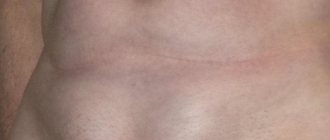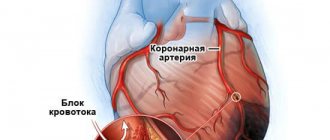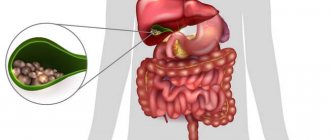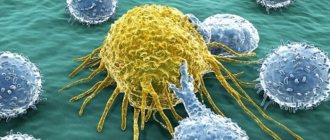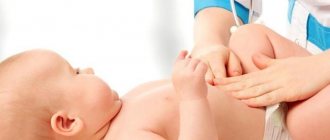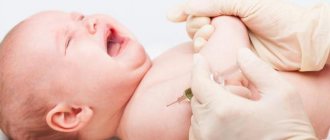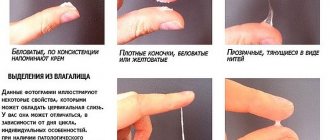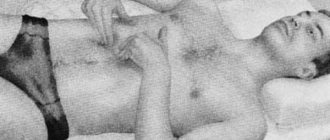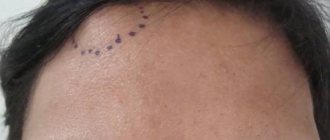Causes and risk factors
The main role in the formation of congenital inguinal hernias in children belongs to the blind pouch of the peritoneum (vaginal process) protruding through the inguinal canal into the scrotum. After the testicle descends into the scrotum, the processus vaginalis becomes obliterated, i.e., overgrown. This usually happens around the time the baby is born. If for some reason obliteration does not occur, then the inguinal canal does not close and when intra-abdominal pressure increases, internal organs emerge through it. The hernial orifice is the outer ring of the inguinal canal, and the processus vaginalis of the peritoneum is a hernial sac, which may include intestinal loops, omentum, fallopian tube and ovary (in girls).
In the development of inguinal hernia in children, hereditary predisposition plays an important role. According to statistics, approximately 12% of children with this pathology also had an inguinal hernia in one or both parents.
Acquired inguinal hernias in children, as mentioned above, are extremely rare. Factors provoking their development:
- obesity;
- sudden weight loss;
- sedentary lifestyle;
- lifting weights;
- respiratory diseases accompanied by severe cough;
- chronic constipation.
Lifting heavy weights as a child is a predisposing factor for inguinal hernia
Complications
One of the most common complications is a strangulated hernia, which requires emergency surgical intervention. The organs trapped in the hernial sac are compressed. In such cases, blood circulation in the strangulated organs is disrupted, which can quickly lead to necrosis. An increase in intra-abdominal pressure often contributes to the development of such a complication, and a strangulated hernia manifests itself with the following signs:
- the child becomes restless and cries;
- the mass in the groin is very painful, cannot be reduced, is tense;
- nausea and vomiting, bloating.
With an inguinal hernia, strangulation is twice as common on the right side. The small intestine is most often strangulated, with necrosis occurring in 10% of cases if left untreated. Perforation and peritonitis may develop. In such cases, resection of the hernial contents is performed.
Rare complications include coprostasis, and if conservative methods do not bring the expected effect, surgical intervention is performed.
Another uncommon complication is inflammation of the hernia. Various reasons can lead to its development: appendicitis, peritonitis, tuberculosis of the abdominal organs, foreign bodies in the contents of the hernial sac.
The ovaries of girls are very sensitive to deterioration of blood supply, therefore even a short-term infringement can lead to necrosis and loss of the ovary. In boys, testicles may also die due to the development of necrosis. Incarceration is a serious threat to fertility in adulthood and requires removal of an inguinal hernia in children.
Forms of the disease
Depending on the location, inguinal hernias in children are bilateral, left-sided and right-sided. In girls, bilateral hernial protrusions are observed in 50% of cases. In boys, bilateral inguinal hernias occur in 10% of cases, in 30% - left-sided, and in the remaining cases - right-sided.
As a rule, in children, inguinal hernias pass through the internal inguinal ring and are located in the inguinal canal, i.e. they are oblique. Direct inguinal hernias are extremely rare in pediatric practice. In this case, the hernial protrusion passes through a defect in the muscles of the anterior abdominal wall in the area of the external inguinal ring.
Inguinal hernias in children are a widespread pathology. They are observed in 5% of full-term and 20-25% of premature babies.
In boys, the hernial sac can descend into the scrotum, which leads to the formation of inguinal-scrotal hernias, which, in turn, are divided into testicular (ovarian) and funicular (cordial).
The first signs of an inguinal hernia
Congenital inguinal hernias are noticeable immediately after birth. The first sign is protrusion of the skin in the form of swelling. It is painless, has a round shape and can completely disappear when the child is calm. If the hernia is large, it is not difficult to notice it; if it is small, it will be detected a little later, when the child begins to become active or cry.
Hernias can be right-sided or left-sided. In some cases, pathological protrusion forms on both sides. In addition, oblique and straight formations are distinguished, and several types are distinguished, depending on the degree of mobility, which is important for the doctor.
Symptoms of inguinal hernia in children
The main symptom of an inguinal hernia in children is the presence of a tumor-like protrusion in the groin area. When the child strains, cries, screams, or coughs, it increases in size, at rest it decreases, and sometimes disappears completely.
With an inguinal-scrotal hernia in boys, deformation of the scrotum is observed due to the lowering of the hernial sac into it. In girls, the hernial sac may descend into one of the labia, causing it to thicken.
Inguinal hernias in children are often accompanied by pain localized in the lower abdomen or groin area. The pain may radiate to the lower back or sacrum. They can cause crying and whims in children in the first year of life. At an older age, children tell their parents about pain in the lower abdomen.
An inguinal hernia in a child manifests itself as a tumor-like protrusion in the groin area
Characteristic symptoms
Parents can detect symptoms of the pathology at any age, starting from birth, but most often boys under two years of age are affected.
The disease manifests itself in the form of an elastic seal in the groin area, which may extend into the scrotum or labia majora.
(if the table is not completely visible, scroll to the right)
| Characteristic signs of a hernia | Signs of her infringement |
| Located on one or both sides (in boys, 60% of hernias are left-sided, in girls more than 50% are bilateral) | Severe pain in the protrusion area |
| Painless when pressed | The child is restless and crying |
| If there is intestine in the hernial sac, then when pressed it rumbles | Weakness |
| When coughing, crying or straining, the formation increases | Constipation |
| When pressing on the protrusion and when in a horizontal position, it is reduced (optional sign) | Gases stop passing (the child does not fart, and at the same time he has bloating) |
| If the hernia is straight, it has the shape of a ball, oblique variants of the protrusion have an oblong shape | If you do not immediately contact a pediatric surgeon in the hospital with signs of infringement, then signs of peritonitis (inflammation of the peritoneum) develop: nausea, fever, vomiting, and possible loss of consciousness. This is already a life-threatening condition. |
| A bilateral hernia can only be oblique |
Left-sided inguinal hernia: this is how it looks in a standing position with tension in the abdominal wall muscles
Diagnostics
An inguinal hernia in children is usually discovered either by the parents themselves or by a doctor during a routine examination.
Palpation reveals an elastic or soft consistency of the protrusion in the groin area. In an uncomplicated course, the hernial contents are easily reduced into the abdominal cavity. At the moment of reduction, you can hear a characteristic rumbling, which indicates the presence of an intestinal loop in the hernial sac. After the hernial protrusion is reduced into the abdominal cavity, the expanded external inguinal ring is palpated.
Inguinal hernias in children are three times more common in boys. Presumably, this is due to the process of migration of the testicle into the scrotum from the abdominal cavity through the inguinal canal.
To clarify the diagnosis, perform:
- ultrasound examination of the abdominal organs, pelvis, inguinal canals and scrotum;
- irrigography;
- cystography.
Inguinal hernia in children requires differential diagnosis with the following diseases:
- femoral hernia;
- inguinal lymphadenitis;
- cyst of the round ligament of the uterus (in girls);
- cryptorchidism (in boys);
- spermatic cord cyst (in boys);
- hydrocele (in boys).
Reasons for the development of pathology
This pathology is very common: it develops in 5% of full-term newborns, and in premature infants – 3–5 times more often (15–25%).
The causes of the development of childhood inguinal hernia are conventionally divided into congenital and acquired.
Congenital causes
Congenital protrusions occur due to connective tissue pathology.
Boys get sick 3–10 times more often than girls. This is due to the fact that in boys with congenital causes, a hernia forms just during the movement of the testicles into the scrotum. They come from the abdominal cavity, where they were formed, and must pass into the subcutaneous inguinal canal.
Girls don't have testicles. The ovaries do not go through the stage of moving, but remain forever where they are formed. Therefore, inguinal hernia occurs extremely rarely in girls.
Congenital hernial protrusion is often combined with pathologies such as spermatic cord cyst, testicular hydrocele, developmental anomalies of the spine and hip joints.
Acquired causes – in childhood
The acquired form of pathology develops as a result of:
- operations on the organs of the scrotum or abdominal cavity, in which an incision is made in the groin area;
- injuries to the area near the pubis;
- significant physical activity (heavy lifting, coughing or uncontrollable vomiting).
Treatment of inguinal hernia in children
Currently, conservative treatment of inguinal hernias in children using adhesive bandages and bandages is not carried out.
Removal of an inguinal hernia in children with an uncomplicated course is performed routinely after the age of six months. During surgery, the surgeon isolates, ties and cuts off the hernial sac, and then performs plastic surgery of the hernial orifice using the patient’s own tissue or using a special propylene mesh.
Attention! Photo of shocking content. To view click on
.
Surgery for inguinal hernia in children can be performed using the classic open method or using laparoscopic technologies. The latter method is more preferable, as it is accompanied by minimal trauma to soft tissues, minor blood loss and a short rehabilitation period.
Removal of an inguinal hernia in boys should be performed with great care to avoid possible injury to the vas deferens and vessels of the testicle (spermatic cord). Their damage subsequently leads to testicular atrophy and/or male infertility.
The development of a strangulated inguinal hernia in girls is an indication for emergency surgery, since there is a very high risk of death of the fallopian tube or ovary. In boys in the first months of life, when strangulation develops in the first few hours, conservative therapy is carried out, aimed at self-reduction of the hernia. In this case, the following treatment regimen for inguinal hernia in children is used:
- warm bath or heating pad;
- intramuscular administration of drugs that have an antispasmodic effect;
- giving the child a position with an elevated pelvis.
If treatment does not lead to strangulation of the inguinal hernia, emergency surgery is resorted to. For strangulated inguinal hernias in children, the operation has its own characteristics. First of all, the surgeon must assess the viability of the organs included in the hernial sac. Reduction into the abdominal cavity is possible only if the viability of the intestine, omentum, ovary or other elements is beyond any doubt. Otherwise, they are resected.
Recurrence of inguinal hernias in children is observed in 1% of cases (most often after emergency interventions or in premature infants).
How does a doctor make the correct diagnosis?
A pediatric surgeon will diagnose the child. He will take into account:
- symptoms of pathology;
- the results of some tests (for example, does the mass protrude when you cough, strain, or walk);
- ultrasound results (which will show which organs are in the hernial sac, whether there are adhesions there or not);
- irrigography data - an X-ray examination with contrast (which will show the presence of intestinal strangulation located inside the hernial sac).
Possible consequences and complications
The main complication of an inguinal hernia in children is its strangulation. It develops as a result of compression of the hernial contents (ovary, omentum, intestinal loop, bladder wall) by the external inguinal ring, which leads to ischemia of the strangulated organs.
Constipation, flatulence, and severe cough can provoke the development of infringement.
The main symptoms of inguinal hernia strangulation in children are:
- pain in the groin (small children cry, press their legs to their stomach);
- the hernial protrusion becomes tense and sharply painful on palpation, it is impossible to reduce it into the abdominal cavity;
- nausea, repeated vomiting;
- bloating;
- delayed passage of gas and stool.
If surgical treatment is delayed, the child develops peritonitis.
Ovarian tissue is very sensitive to ischemia, so even short-term strangulation can cause ovarian necrosis and egg death.
Infringement is also dangerous for the male reproductive system. Thus, 5% of boys, after suffering an inguinal hernia strangulation, subsequently develop testicular atrophy.
Treatment
An inguinal hernia is treated only surgically (in both adults and children). The operation is performed starting from 6 months of age.
Bandages, compresses, strengthening the hernial orifice with a plaster are ineffective treatment.
If the operation is performed as planned, without waiting for complications to develop, then it is performed laparoscopically through 3 small incisions. Laparoscopic intervention is performed in 15–30 minutes under anesthesia, and the child can be discharged home the next day.
Laparoscopic surgery is performed through small incisions on the anterior abdominal wall. The surgeon performs the intervention using manipulators, and he sees what is happening in the abdominal cavity on the monitor.
The essence of the operation is to dissect the hernial sac and move the organs in it “into place” - into the abdominal cavity. Then the hole through which the organs emerged is reinforced with one’s own tissue or polypropylene mesh to prevent recurrence of hernia.
After the operation, it is necessary to wear a bandage, which is worn only while lying down and initially removed only at night. After 14 days, they begin to lengthen the time of walking without a bandage during the day.
In the postoperative period, it is very important to engage in physical therapy and abdominal massage, which activates blood circulation in this area and will serve as an excellent prevention of hernia in the future.
Treatment for strangulation
If an inguinal hernia is strangulated, urgent hospitalization is required in a children's hospital, which has a surgical department. There, within 1–2 hours, doctors can reset the pinched organs into the abdominal cavity using conservative methods using:
- administration of drugs that relieve intestinal spasms;
- emptying parts of the intestine located further than the strangulation, with careful attempts to straighten the contents.
If there is no effect, urgent surgery is performed.
Forecast
Removal of uncomplicated inguinal hernias in children is currently performed in most cases in a day hospital. The child is discharged for outpatient treatment on the day of surgery or the next morning.
Recurrence of inguinal hernias in children is observed in 1% of cases (most often after emergency interventions or in premature infants).
Complications of hernia repair occur extremely rarely. These include:
- infertility;
- high testicular fixation;
- lymphocele;
- testicular lymphostasis.
Preventive measures
Since inguinal hernias in children in most cases are congenital, the main preventive measure is to determine the likelihood of developing the disease (relatives who have been operated on for a hernia), as well as timely examinations of the child by a doctor.
Avoiding significant physical activity will help prevent the appearance of an acquired hernia, as well as normalizing intestinal function - timely treatment of constipation.
In any case, sooner or later, a hernia will require surgical intervention, and no other methods are effective.
Video from YouTube on the topic of the article:
Symptoms
An inguinal hernia in a newborn boy can appear either immediately or in the first two months of life. Diseases that contribute to the development of this pathology are any that cause exhaustion or weight loss in a child.
Are common
The condition of the baby does not change. The protrusion is completely painless and does not cause any inconvenience to the baby. Rarely do aching pains and discomfort appear, especially after movements, which the baby’s parents can recognize from the child’s crying, whims, and restlessness.
If treatment is delayed indefinitely, the following symptoms will appear:
- constant aching pain, discomfort,
- stool retention,
- bloating, flatulence,
- occasionally, urinary disturbances.
Local
Directly in the area of pathology - in this case, a certain formation appears in the groin, which has characteristic signs:
- any size - from tiny and almost invisible to 10 or more centimeters,
- elastic to the touch,
- oval or round,
- changes when moving - for example, in a lying position there is nothing, but while sitting or standing, the “tumor” appears again,
- increases when the child strains his tummy - screams, sneezes, coughs, etc.,
- “rumbling”, gurgling is a signal of the intestines leaving the abdominal cavity.
You can understand what a hernia looks like by looking at the photo below. Externally, an inguinal hernia in boys is the most common “bump” of skin, practically no different from the rest of the skin.
Postoperative treatment
All hernias after their surgical treatment have a high probability of recurrence. To avoid such a complication, you must follow your doctor's instructions during the recovery period. The child must wear a bandage. You only need to wear a fixative bandage during prolonged coughing, crying, or active movements.
To strengthen your abdominal muscles, you need to do gymnastics daily. Types of exercises are selected individually depending on the age of the child.
It is imperative to follow a dietary diet. Foods that can cause constipation, bloating, and gas accumulation are excluded from the child’s diet. All this can cause an increase in intra-abdominal pressure and provoke the recurrence of a formation in the groin.
Why is it dangerous?
The most common complication of the disease is a pinched inguinal hernia.
This phenomenon is considered very dangerous for the child’s health, as it provokes disruption of the digestive system and contributes to the development of symptoms of intoxication of the body.
In addition, the strangulated organ dies over time ( necrosis ), this leads to irreversible consequences.
In some cases, when the appendix prolapses into the hernial sac, the child develops appendicitis with symptoms characteristic of this disease. The inflammatory process begins, poisoning the body. The child requires urgent medical attention .
The lack of proper treatment of an inguinal hernia in childhood can subsequently lead to serious problems in the functioning of the genitourinary system.
In particular, urination processes are disrupted and infertility .
Treatment of the disease
An inguinal hernia can only be treated surgically. Elective surgery is prescribed for children over 6 months of age and is performed under general anesthesia. The duration of the operation is about 15 minutes.
Temporarily, wearing a bandage is prescribed as a conservative treatment. It prevents the contents of the hernial sac from falling out and keeps it in the peritoneum. It should be put on the child only in a lying position. It is usually worn during waking hours.
For weakened, premature babies, doctors try to straighten the contents of the hernial sac using conservative methods: they prescribe special solutions, a warm heating pad, and warm baths. If no positive effect is observed, emergency surgery is performed. Emergency surgery is also performed for strangulated hernia.
Methods of surgical treatment
Inguinal hernias require surgery, and to avoid the risk of entrapment of abdominal organs, surgery is performed as soon as possible.
If there is an inguinal hernia, treatment without surgery will be ineffective. Removing a hernia surgically is the only effective method.
Sometimes doctors recommend children wear a bandage. This treatment procedure is prescribed when surgery is contraindicated.
Contraindications for hernia repair:
- the body is severely exhausted;
- There are concomitant serious conditions.
The size and type of bandage is selected strictly individually depending on the location of the hernia. The bandage is not able to eliminate the hernia. It only prevents strangulation of the hernia and protects against complete loss of organs into the resulting sac.
Surgery to remove an inguinal hernia in children is necessary in all cases, even if the hernia is not yet pinched. The child should not eat for 6 hours before surgery to reduce the risk of vomiting and aspiration (inhalation of fluids or vomit) during anesthesia.
Only unstrangulated hernias can be set back. If the organs are nevertheless pinched, the pathology can only be corrected by surgical intervention. The quality of the result depends on the degree of neglect of the process and the stage at which treatment begins. Conservative therapy is theoretically possible, but is not currently used. It involves constantly wearing bandages or compression garments, which will prevent the organs from protruding outward.
For young children, surgery is performed at the age of 6-12 months. The procedure involves cutting off the hernial sac and restoring the normal anatomy of the inguinal canal. This may also require strengthening the affected area with your own tissue.
Surgical treatment can be performed openly and using laparoscopy. The second technique is preferable, as it has fewer side effects and requires minimal tissue incisions. When performing the procedure, the surgeon must be careful not to damage the spermatic cords, otherwise this will disrupt reproductive function.
The operation is performed by a doctor in a hospital setting and if the outcome is successful, the child can be transferred to home treatment.
If a girl's hernia is strangulated, emergency surgical intervention is indicated, as there is a high probability of ovarian atrophy and impaired reproductive function. If a hernia is strangulated in boys, measures can be taken to independently reduce the organs:
- take a warm bath;
- take antispasmodics to relax muscles and widen the hernial gap;
- position the child horizontally or lift his pelvis upward to make it easier for the organs to “return.”
The prognosis for a child with an inguinal hernia is, in most cases, favorable. For uncomplicated conditions, surgical treatment is very effective. Before surgical reduction of strangulated hernias, it is necessary to first ensure the viability of the organs. If their blood supply has been severely impaired and necrotic areas have appeared, the doctor performs a resection.
Operation
Sometimes it is impossible to do without surgical treatment for such pathology. The procedure is carried out at one year of age. Using special instruments, the doctor separates the hernial sac and the abdominal cavity, placing the internal organs in their anatomical places. The patient is operated on under general anesthesia. Parents are concerned about how long the operation lasts. The procedure takes 15-30 minutes. The technique of performing the manipulation is simple, but the doctor must have the appropriate qualifications.
There are 2 ways to remove an inguinal hernia: open (hernia excision) and laparoscopic. Depending on the method of strengthening the walls of the inguinal canal, hernioplasty can be tension or non-tension. During tension plasty, the walls are sutured; with the non-tension method, the canal walls are reinforced with synthetic materials (polyester or polypropylene mesh).
The exception is late requests (4-5 days). Patients are admitted in serious condition with severe intoxication, dehydration and often with peritonitis - inflammation of the peritoneum.
Before the operation, the following manipulations are carried out:
- a 10% glucose solution is administered intravenously;
- perform blood transfusions;
- They give antipyretic and heart medications.
Hernia excision
Hernia excision is an outdated term for surgery to remove a hernia. There are about a hundred options for hernioplasty. The method is that when a hernia is removed, an external incision is made in the anterior wall of the abdomen at the site of the protrusion, the hernial orifice is sutured, and the walls of the inguinal canal are strengthened.
At home, it is important to observe bed rest for 3-4 days. The child is prescribed laxatives and a special diet. Sutures are removed 7 days after surgery. Physical activity is not recommended for the next 6 weeks.
Laparoscopy
An alternative to the traditional surgical method is laparoscopy. This is a closed operation performed using a laparoscope. Removal of a hernia occurs without an incision in the peritoneum, through punctures in the navel area. Under the control of equipment, the doctor performs tissue plastic surgery with the installation of a reinforcing mesh. Laparoscopy of inguinal hernia has several advantages:
- the procedure is not as traumatic as hernia repair;
- the child’s recovery period is shorter;
- There are fewer relapses and complications such as damage to the spermatic cord are excluded.
Treatment of inguinal hernia in children is carried out surgically. A planned operation is scheduled, and the baby is prepared for hernia repair. Removing a hernia always has risks, but without treatment the disease is even more dangerous.
The goals of treating a hernia in a newborn will be:
- elimination of unpleasant sensations - wearing a bandage, preventing colic and bloating;
- prevention of pinching - avoid sudden movements, relaxing massage;
- normalization of blood circulation in the pelvic organs - exercise therapy, swimming;
- hernia removal - hernioplasty.
An integrated approach to a hernia in a boy includes the following measures:
- Wearing a groin bandage. Such a useful device is necessary before and after surgery in order to fix the hernia, which will prevent the progression of the disease. A correctly selected bandage, taking into account age-related characteristics, will allow the child to safely perform various movements without the risk of injury. But such a belt can also cause harm. If you use an inguinal bandage for a long time, this will lead to muscle weakness, aggravate the child’s condition, and become a factor for relapse after surgery.
- Physiotherapy. A boy with an inguinal hernia needs gymnastics to strengthen the muscles of the inguinal canal. It is useful to exercise with your child in the pool, on a fitball and on a regular changing table. Exercises are selected by the doctor, but usually these are simple rotations of the legs, turning the baby from back to side, “scissors” and others. You need to work with your child when he is feeling well.
- Massage. It is possible to perform a massage for a hernia, but first you need to check with your doctor which movements are undesirable for the child. Massaging the tummy is also useful in case of digestive problems, which often accompany a hernia.
Operation
Elective hernioplasty is the main treatment method for inguinal hernia in boys. The operation lasts no more than 40 minutes, the duration and type of pain relief will depend on the technique. Hernioplasty is performed using a closed or open method. In the first case, access to the hernia is created through small punctures of the abdominal wall, after which there are no wide scars left.
Open surgery involves a wide incision of up to 10 cm, which allows you to quickly suture the defect and remove pathological tissue manually. In the case of laparoscopy (closed method), the child’s recovery is faster, the operation has better cosmetic results, but this is a complex technique that requires high professionalism and is not forgiving of the surgeon’s mistakes.
Laparoscopic surgery is performed under video control and is a minimally invasive technique. The risk of complications after such an operation is lower, because minimal tissue trauma occurs.
Hernia treatment can be surgical. Sometimes young patients may be prescribed non-operative treatment for protrusion. It is used only when the size of the protrusion is insignificant and it does not pose a health hazard. You can easily repair a hernia at home.
Conservative
Boys are sometimes given a set of therapeutic measures to conservatively reduce the hernia.
After the hernial sac relaxes, it is automatically reduced. Massage of the sore area is also indicated. This method is effective in about a third of cases. If after applying all these measures no protrusion occurs, then surgery is prescribed.
The child can undergo a massage, after which the hernia can be independently reduced.
If there are indications for surgery, conservative treatment is carried out only in weakened and premature children. Its duration does not exceed 12 hours.
There are the following effective folk remedies for the treatment of inguinal hernia in children:
- 1 tbsp. Dried knotweed herb pour 1 cup of boiling water, leave for 10 minutes, take 60 ml before meals 3 times a day. The duration of treatment is 2 weeks, after which the hernia will disappear.
- Place a copper coin on the groin area and secure it with an adhesive plaster. It can only be removed during water procedures. You need to hold the coin until the hernia disappears completely.
- Apply gauze with sauerkraut juice to the affected area, cover it with a slice of potato (fresh). The duration of the procedures is about 1 month.
It is not worth using a spell when treating a hernia in an infant; it is ineffective and cannot have healing power.
Treatment of inguinal hernias in children
INGUINAL HERNIA: THE WHOLE TRUTH FOR PATIENTS
Homeopathy
For homeopathic treatment of hernia, the following drugs are used:
- metallic gold - if the protrusion is prone to falling out;
- fishing berries - when you feel strong pressure in the abdominal cavity;
- blue wrestler - in the presence of severe pain;
- chilibukha - when feeling weak.
Surgery
Surgical measures are carried out in the absence of effectiveness of conservative treatment. In case of strangulated protrusions, intervention is carried out on an emergency basis. In the case of a long-standing pathology and if there are signs of compression of the contents of the sac, the operation is performed immediately, without attempting conservative therapy.
The intervention is usually performed using masked general anesthesia for several minutes. If the congenital hernia is oblique and there is no threat of strangulation, the doctor may recommend conservative treatment. It consists of constantly wearing a special bandage until the child reaches 4-5 years of age. If this method is ineffective, after four to five years the patient is prescribed surgery.
Manifestations of the disease
The main symptom of an inguinal hernia in boys and girls is a protrusion in the groin area. With an inguinoscrotal hernia, the hernial protrusion extends to the bottom of the scrotum. The protrusion becomes especially noticeable after physical activity, when a child cries or screams, which is associated with an increase in intra-abdominal pressure. An uncomplicated inguinal hernia has a soft-elastic consistency; when pressed, it is easily, without difficulty, reduced into the abdominal cavity, sometimes with rumbling if the contents are a loop of intestine. Palpation and reduction of an uncomplicated inguinal hernia does not cause any discomfort to the child.
Hydrocele of the testicular membranes is quite common in newborn boys. In this case, swelling in the scrotum area is visually determined, sometimes disappearing, sometimes increasing, especially when screaming or crying.
As a rule, hydrocele of the testicular membranes in young children disappears spontaneously during the first year of life. If dropsy persists at an older age (after 2 years), surgical treatment is required.
Why and how does an inguinal hernia occur?
The main role in the formation of inguinal hernias in children is played by the “vaginal process” (see Fig. 2), which develops in the abdominal cavity of the fetus from 12 weeks of intrauterine development. Essentially, the vaginal process is a protrusion of the peritoneum into the groin area, outside the abdominal cavity. The main task of the vaginal process is the descent of the gonads (the process of descent of the testicles from the abdominal cavity into the scrotum). After the descent of the testicles, a complex, hormone-dependent process of obliteration (fusion) of the vaginal process occurs (Fig. 2a). It is the disruption of this process that creates the preconditions for the development of inguinal hernias (Fig. 26), hydrocele of the testicular membranes or cysts of the spermatic cord. The introduction of a strand of the omentum1, a loop of intestine, and, in girls, the ovary into the vaginal process in the overwhelming majority of cases leads to the formation of an inguinal hernia. Thus, the vaginal process is a hernial sac, along the posterior wall of which in boys there are elements of the spermatic cord, and in girls - the round ligament of the uterus and its accompanying elements.
The appearance of a hernial protrusion in the inguinal or inguinal-scrotal area should alert parents and become a reason to contact a pediatric surgeon. Currently, planned surgical treatment of inguinal hernias in children is usually carried out immediately after diagnosis. However, in children under 6 months of life, especially with any concomitant pathology, in the presence of free reduction of the hernial contents, surgical treatment can be postponed until the second half of the first year of life. It should be remembered that this child should be under the supervision of a pediatric surgeon, and parents should be informed about the symptoms of a strangulated hernia. Even one episode of infringement is an indication for elective surgery.
Back to contents
Child examination
Before treating an inguinal hernia, the child undergoes a comprehensive examination. Diagnosis begins with an external examination. The surgeon sees a characteristic protrusion in the groin and the absence of signs of similar diseases. To confirm the diagnosis and choose treatment tactics, an ultrasound examination is performed. In the image, the doctor sees the contents of the hernia sac and the condition of the surrounding structures.
During the diagnostic process, the doctor determines the shape of the hernia, it can be:
- inguinal
- located in the area of the external opening of the inguinal canal; - inguinal-scrotal
- located near the testicle, affecting the scrotum; - cord
- located in the scrotum above the testicles, near the spermatic cord; - oblique
- passes through the groin canal near the spermatic cord; - straight
- passes through the peritoneum without affecting the inguinal canal; - combined
- oblique and straight appearance, which arose independently of each other.
A special approach to the child is needed when identifying a strangulated hernia. This condition is life-threatening and therefore requires immediate surgery. Incarceration is the compression of organs in the area of the hernial ring or directly in the sac, which is accompanied by ischemia and death of the compressed tissue.
Characteristic signs of inguinal hernia strangulation in girls and boys:
- strong pain;
- boy's anxiety and crying;
- tension of protrusion, impossibility of its reduction;
- lack of stool;
- nausea and vomiting;
- pallor of the child, decreased activity.
Types of disease
The most common types of illness, due to the peculiarities of the development of the body, are inguinal and umbilical. They occur in 90% of all cases. But a hernia can be located almost anywhere in the body, so special attention is required to various formations on the body of a newborn boy.
Inguinal hernia
Inguinal hernia is the most common pathology of this type. It occurs mainly in boys due to the peculiarities of the development of their body. With an inguinal hernia, the following may bulge:
- stuffing box,
- intestinal loop,
- ovary.
This disease comes in three types: direct, oblique, bilateral. Differences in the location of the hernia and its development. So, for example, with the oblique type, the disease develops on the right side.
A bilateral hernia is more dangerous: in order to completely remove it, two operations will be required. During the first, the hernia is removed on one side, and during the second, on the other. The interval between operations must be at least 6 months.
Umbilical hernia
The second most common hernia among newborn boys is the umbilical hernia.
In order to understand why it occurs, let’s look at how the navel is formed in a newborn baby: within five days after ligation of the umbilical cord, its remnants dry out and fall off on their own, and the area of the umbilical ring contracts, scars and becomes covered with a skin fold. If However, this does not happen, and the umbilical ring remains not completely tightened; parts of organs (intestinal loops, greater omentum, peritoneum, etc.) can pass through this hole.
Testicular hernia
A not so common form of hernia, and it occurs, logically, only in boys. The fact is that during embryogenesis in the womb, the process of lowering the testicles into the scrotum occurs. If the process has not started or any problems have arisen, we can talk about sexual dysfunction and testicular hernia. It can be acquired, and it also occurs in children or teenage boys. The appearance may be facilitated by:
- constant stress,
- strong physical activity.
If there is the slightest suspicion of the development of this type of hernia, you should immediately consult a doctor, as there is a significant risk of the child’s life or complete death of the testicle. Symptoms:
- testicular tumor,
- unnatural appearance of the scrotum,
- pain in the groin area.
if the hernia begins to be strangulated, there will be a significant risk to the baby's life, and emergency surgery will be required. It is believed that this disease occurs due to the underdevelopment of connective tissue near the linea alba of the abdomen: the tissue is quickly depleted, which is why holes appear in the aponeurosis.
Quite a rare disease. With it, the abdominal organs move into the chest. This occurs due to the presence of a congenital predisposition (some kind of diaphragmatic pathology). The pathology is formed already in the fourth week of development in the womb: at the stage of development of the formation of a membrane between the abdominal cavity and the pericardial cavity. It is still unknown what causes the development of a diaphragmatic hernia, but it is generally accepted that this is:
- severe pregnancy,
- frequent constipation,
- complicated childbirth,
- chronic diseases in women,
- taking some honey drugs,
- bad lifestyle.
The only method of treatment for newborn children is surgery: immediately after birth, artificial ventilation of the lungs is performed, and then the operation itself. It is divided into two stages:
- If a child has insufficient abdominal volume, an artificial hernia (ventral) is created.
- During the second stage (which takes place over a very wide period of time: from 6 days to six months), the artificial hernia is removed and the pleural cavity is drained.
Operation
Perhaps the best way to combat pathology, because it excludes further development. Suitable for absolutely all types of hernias in newborn boys, so if you have a choice: surgery or treatment at home, it is recommended to choose the first. But do not worry, because the operation involves not only “cutting something”, but also the banal realignment of the growth .
A completely valid way to eliminate some simple types of hernia. Self-treatment can be understood as:
- massage,
- special creams,
- medicines,
- various gymnastic procedures and exercises.
If by treatment with folk remedies we mean various female healers who are ready to pray for a child, cast a spell or cast some kind of spell, then this is not even treatment.
There are no folk remedies that have proven their effectiveness, much less greater (!) effectiveness than standard medical methods: operations and medications. They should be avoided and treated under medical supervision.
Inguinal hernias are either direct or oblique. Oblique hernias pass through the inguinal canal along with the spermatic cord, direct hernias pass outside it. There are three types of indirect hernias: canal, cord and inguinoscrotal. In the inguinal-scrotal variant, the hernial sac is located in the scrotum. There are also combined hernias. They consist of several hernias that are not connected to each other.
According to their characteristics, hernias are divided into reducible and irreducible. The former tend to appear and disappear on their own, while the latter cannot be eliminated (reduced) due to the fusion of the hernial sac with its contents.
Classification
Hernias are classified according to different criteria. Depending on the location, the following types of hernia are distinguished:
- inguinal (the protrusion is localized near the external opening of the canal);
- funicular (protrudes, descends towards the scrotum and reaches the level of the testicles);
- inguinal-scrotal (the pathological process affects the scrotum and is located at the level of the testicles).
Pathologies are:
- unilateral or bilateral (a bilateral hernia is characterized by damage on both sides of the abdominal cavity, while in the unilateral version, the pathological formation is fixed only on one side);
- reducible;
- irreducible (in this case, the body is at risk of developing an adhesive process, in which connective tissue bridges appear between the organs of the abdominal cavity);
- strangulated (squeezing of organs located in the sac occurs);
- undisturbed.
Depending on the location, an inguinal-scrotal hernia is distinguished, when the pathological process affects the scrotum and is located at the level of the testicles.
Direct
With a direct hernia, the protrusion passes through the weakened abdominal wall and bypasses the internal opening of the inguinal canal. This disease is acquired.
Most often, hernias of this type occur in children who actively engage in sports or physical labor.
The standard procedure for treating a direct inguinal hernia is surgery. It can be repeated if a relapse is diagnosed.
Oblique
The protrusion passes through the inguinal canal and is located near the spermatic cord. This hernia is detected if it descends into the scrotum. It occurs in newborns, but can also occur in older patients.
Surgery to remove this type of hernia is performed according to a standard procedure. If the disease is detected in newborns, the doctor recommends doing it as early as possible to avoid the development of complications. In some cases, parents are advised to wait until the age of two.
In older children, treatment for indirect hernia is only surgical.
In older children, treatment of indirect hernia is carried out only with the help of surgery.
Combined
On one affected side, 2 or more pathological protrusions may be observed. This type of hernia is most often acquired. Its treatment, like other types of hernias, is surgical.
Prevention
To prevent the appearance of pathology and its impairment, it is recommended not to let the baby cry a lot and often; from the first days of life, you need to do gymnastics.
Simple exercises will help strengthen the abdominal muscles, prevent constipation and colic, and improve intestinal motility.
Women who are breastfeeding need to follow a diet. If the appearance of an inguinal hernia could not be avoided or the pathology is congenital in nature, it is necessary to carry out timely conservative treatment.
Treatment of umbilical hernia
Here are some general recommendations for the treatment of hernia in newborns and infants:
- Place your baby on his stomach frequently;
- Make sure that your baby has regular bowel movements and prevent constipation and flatulence;
- Do not let your child scream profusely and hysterically;
- Do strengthening massage and gymnastics. The basic techniques are not difficult to learn, after which the mother can do massage and gymnastics on her own.
Massage technique for umbilical hernia
The massage begins with light stroking movements on the baby’s stomach in a clockwise direction (along the intestines). To do this, place your palm on your stomach so that the navel is located in the center of the palm and turn your hand clockwise. Another technique for strengthening the abdominal muscles is to place your hands on the baby's sides (at the level of the obliques) and use gentle stroking movements from below (from the back) to the navel. Lightly pinching around the navel helps strengthen the muscles (also done clockwise), tapping with your fingertips in the navel area - these are the basic techniques. Hands should be warm during the massage. It is better to massage the abdomen 30-40 minutes before meals or 1.5-2 hours after on a hard, flat surface. They begin to massage after the umbilical wound has healed.
No manipulations are carried out in the umbilical ring itself! All this is done 1-2 times a day, increasing the duration as the baby grows.
To better master the techniques of massage and gymnastics, ask a massage therapist or nurse to show them, in this case you will be sure that you are doing everything correctly.
Regarding the reduction of a hernia using a coin and a patch, this method is currently not used due to the high risk of infection of the umbilical wound. Reduction of the hernia followed by fixation with an adhesive plaster should be carried out by a doctor. Now they produce special hypoallergenic patches for the treatment of umbilical hernia.
In cases where the size of the hernia is more than 2 cm, there is an increase in its size and it does not disappear on its own by the age of 5, surgery is indicated.
A hernia in an infant may require emergency care - in cases where the hernial sac becomes painful, dense, and cannot be reduced. These symptoms may indicate a strangulated umbilical hernia. This is a very dangerous condition as part of the intestine gets stuck in the umbilical ring, which can lead to intestinal obstruction and necrosis of part of the intestine. If there is a strangulation, emergency surgery is performed.
Many parents try to try all methods to help their baby. So, the conspiracy of umbilical hernia in infants is quite popular. Well, if you have been recommended a good traditional healer and you really believe that he will help you, then why not talk about an umbilical hernia in a baby. Just don’t forget about traditional methods of treatment. And focus on strengthening the abdominal muscles and preventing diseases that contribute to the progression of the hernia (constipation, flatulence, rickets and others).
